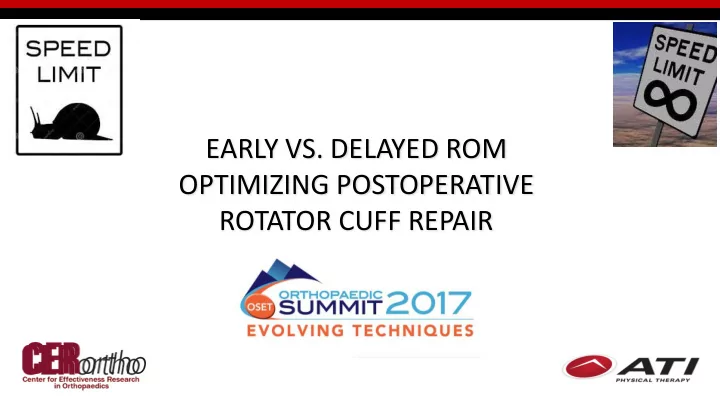

EARLY VS. DELAYED ROM OPTIMIZING POSTOPERATIVE ROTATOR CUFF REPAIR
Disclosures Royalties and stock options One Direct Health Players Health Consulting income BREG Arthrex Research and education support Arthrex BREG The Hawkins Foundation Foundation for Physical Therapy
• Immobilization alone was only used in 1 RCT • ”protected” ROM most common comparison • No apparent effect is < 3cm with NO IMMOBILIZATION (Sheps et al 2015)
#1 Timing and Expectations? • Duration of problem • Any “pre-op” rehabilitation? • Why did they have surgery? • Goals • Cross fit vs laborer vs golfer
#1 Timing and Expectations? • Duration of problem • Any “pre-op” rehabilitation? • Why did they have surgery? • Goals • Cross fit vs laborer vs golfer
Timing & Size Matters “ Successful” clinical outcomes widely reported for rotator cuff repair (Wilson ’02; Galatz ’04; Burkhart ’01; Tauro et al ‘98; Gartsman ’98) 25%-95% anatomic failure of cuff repair reported (Oh et al ‘09; Nho et al JSES ’09; Huijsmans et al ’07; Galatz et al ’04; Harryman et al ’91) When- 98% in 1 st 6 months Repairs of tears > 4cm fail < 12 wks (Miller et al AJSM ‘11) Repairs of tears < 3cm fail 3-6 months (Iannotti et al JBJS ’13)
Patient Outcome Expectation
What Happens if this Fails? Debridement/ tenotomy Arthroscopic/Ope n Repair Reverse Total Ms Transfer
#2 Education Sets Expectations
Key Early Education ADL’s Common mistakes: Door management Bed mobility & rising from chair Toileting & dressing Est appropriate functional goals ROM for desired tasks Loading- how much after 12 weeks “this is your box” for the next 3 months
#3 Standardized Post Op Plan Rehabilitation plan to match the surgery and the patient
Biceps & Tear Size Impact Length of Stay 300 Tenodesis P <0.05 * Tenotomy 250 200 LOS (Days) 150 100 * 50 0 <3cm >3 cm Tear Size
Visits Over Time P <0.05 P <0.05 Biceps Tenotomy Biceps Tenodesis
High Utilizers Smaller Improvement with Small Tears 80 P <0.05 ASES Change Score <3cm >3cm 70 60 * 50 40 30 20 10 0 High Average Low Level of Utilization
Risk Factors for Stiffness Calcific tendonitis, adhesive capsulitis, PASTA [partial articular surface tendon avulsion]-type rotator cuff repair, concomitant labral repair, or single-tendon cuff repair) “Additional ROM exercise was effective is preventing stiffness in 100 consecutive cases” (Koo et al ’12)
Risk Factors for Stiffness Calcific tendonitis, adhesive capsulitis, PASTA [partial articular surface tendon avulsion]-type rotator cuff repair, concomitant labral repair, or single-tendon cuff repair) “Additional ROM exercise was effective is preventing stiffness in 100 consecutive cases” (Koo et al ’12)
PROM (Uhl et al ‘10; Gaunt & Uhl JOSPT ‘11)
ER then FE- ROM 1 st Hold vs. cycles….
When Joint Mobilization? Grade III mobilizations assessed in 9 cadaveric shoulders Measured strains & GAP distances on repaired (0 abd) in anterior/superior repairs • When protocol begins to use AROM < strain at 30 than 0 degrees abd • To end feel and not beyond 30 degrees abd mob similar to relaxed positions Higher with inferior glide • Should be comfortable 0 mm GAP distances at 30 degrees 1.06-1.46 mm at 0 degrees Muraki et al. Manual Therapy. 2007 Aug; 12 (3): 231-9.
#4 Not just initiation of PROM…. ➔ Increased risk of “re-tear/non healing” with early AROM ➔ ~ 25% of strength & stiffness @ 12 weeks o < 3cm early 1.63x o > 3m early 2.5x Schlegel et al ‘99; Arnoczky et al ‘88, Rodeo et al ‘93, St Pierre o > 5cm 6x et al ‘95 Hsu et al ‘16
#5 Controlled Loading & Return to Function >50% 40-60% 25-50% • All suggested exercises < 40% rotator cuff EMG
Great < 90 then Fight Gravity Lower trapeizus Middle trapezius Serratus anterior Posterior rotator cuff
Then more dynamic exercieses
#5 Matched Return to Activity to Patient ➔ No heavy lifting 4-6 months ➔ Sport progressions o Golf 14-16 weeks o Tennis 20-22 weeks o Swimming 22-26 weeks Fealy S et al. ’02; McKee MD et al. 00; Ellman et al ‘86; Charousset et al ‘08) Bjorkenheim, J. M. et al.
Healing Time to Function
@chuckthigpen charles.thigpen@atipt.com QUESTIONS?
Recommend
More recommend